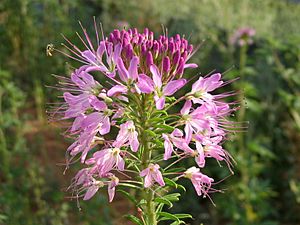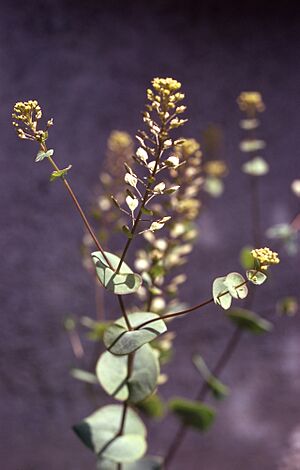List of Capparales of Montana facts for kids
Did you know that Montana is home to many different kinds of plants? Among them are at least 171 types of plants from a special group called Capparales. This group includes plants like capers, mignonettes, and mustards. Some of these plants are native to Montana, meaning they grew there naturally for a long time. Others are exotic or introduced species, which means they were brought to Montana from other places. Some of these plants are even considered Species of Concern, which means they need extra protection to make sure they don't disappear.
Cool Caper Plants

Capers are part of the plant family called Capparaceae. These plants often have pretty flowers and interesting seeds.
- Cleome lutea, also known as the yellow beeplant, has bright yellow flowers.
- Cleome serrulata, the Rocky Mountain beeplant, is known for its tall, pinkish-purple flowers. Bees love it!
- Polanisia dodecandra is called common clammyweed because it can feel a bit sticky.
Meet the Mignonettes
The mignonette plants belong to the Resedaceae family.
- Reseda lutea is known as the yellow mignonette. It has small, yellowish-green flowers that grow in tall spikes.
Amazing Mustard Plants
The mustard plants are a very large group in Montana, belonging to the Brassicaceae family. Many of the vegetables you eat, like broccoli, cabbage, and kale, are related to these wild mustards!
Here are a few examples of the many mustard plants you can find in Montana:
- Brassica juncea is known as Chinese mustard.
- Brassica nigra is black mustard, often used to make mustard spice.
- Capsella bursa-pastoris is called common shepherd's purse because its seed pods look like old-fashioned purses.
- Descurainia sophia is herb sophia.
- Hesperis matronalis is a pretty plant called dame's rocket, with purple or white flowers.
- Lepidium perfoliatum is known as clasping pepper-grass.
- Raphanus sativus is the garden radish, which you might recognize from your salad!
- Sinapis arvensis is corn mustard.
- Thlaspi arvense is field pennycress.
Many of these mustard plants are important parts of the ecosystem. Some are food for wildlife, while others help improve the soil.


